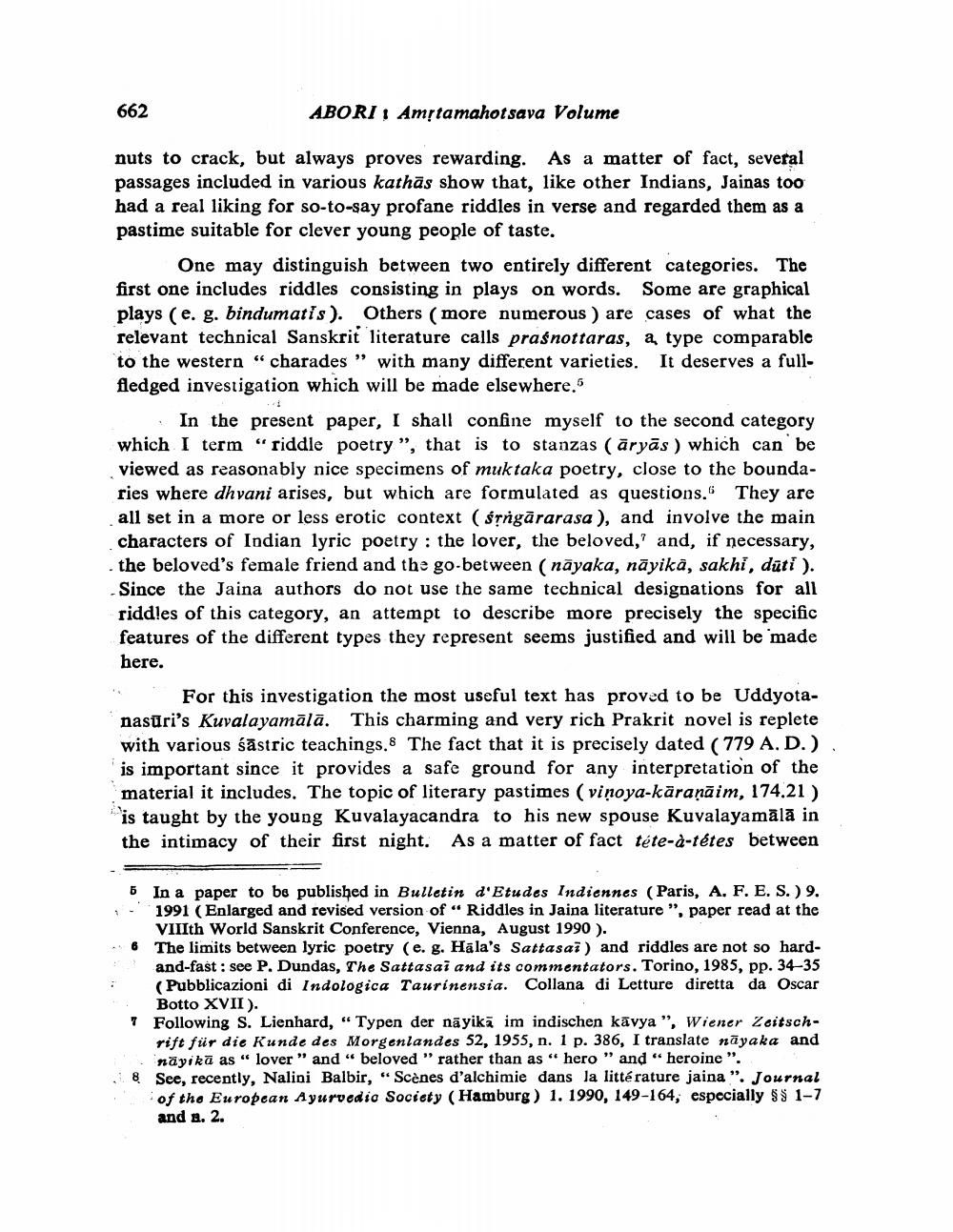Book Title: Prakrit Riddle Poetry Author(s): Nalini Balbir Publisher: Nalini Balbir View full book textPage 2
________________ 662 ABORI I Amộtamahotsava Volume nuts to crack, but always proves rewarding. As a matter of fact, several passages included in various kathās show that, like other Indians, Jainas too had a real liking for so-to-say profane riddles in verse and regarded them as a pastime suitable for clever young people of taste. One may distinguish between two entirely different categories. The first one includes riddles consisting in plays on words. Some are graphical plays (e. g. bindumatis). Others (more numerous ) are cases of what the relevant technical Sanskrit literature calls praśnottaras, a type comparable to the western “charades" with many different varieties. It deserves a fullfledged investigation which will be made elsewhere. In the present paper, I shall confine myself to the second category which I term "riddle poetry", that is to stanzas (āryās ) which can be viewed as reasonably nice specimens of muktaka poetry, close to the boundaries where dhvani arises, but which are formulated as questions. They are all set in a more or less erotic context (śrrigārarasa ), and involve the main characters of Indian lyric poetry : the lover, the beloved,' and, if necessary, the beloved's female friend and the go-between (nāyaka, nāyikā, sakhi, dūti ). Since the Jaina authors do not use the same technical designations for all riddles of this category, an attempt to describe more precisely the specific features of the different types they represent seems justified and will be made here. For this investigation the most useful text has proved to be Uddyotanasūri's Kuvalayamālā. This charming and very rich Prakrit novel is replete with various śāstric teachings. The fact that it is precisely dated (779 A. D.) is important since it provides a safe ground for any interpretation of the material it includes. The topic of literary pastimes (viņoya-kāraņāim, 174.21 ) is taught by the young Kuvalayacandra to his new spouse Kuvalayamālā in the intimacy of their first night. As a matter of fact tête-à-têtes between 6 In a paper to be published in Bulletin d'Etudes Indiennes (Paris, A. F. E. S.) 9. - 1991 (Enlarged and revised version of “Riddles in Jaina literature ", paper read at the VIIIth World Sanskrit Conference, Vienna, August 1990). 6 The limits between lyric poetry (e. g. Hala's Sattasai) and riddles are not so hard and-fast: see P. Dundas, The Sattasai and its commentators. Torino, 1985, pp. 34-35 (Pubblicazioni di Indologica Taurinensia. Collana di Letture diretta da Oscar Botto XVII). Following S. Lienhard, “Typen der nāyikā im indischen kävya ", Wiener Zeitschrift für die Kunde des Morgenlandes 52, 1955, n. 1 p. 386, I translate nāyaka and näyika as " lover" and " beloved " rather than as “hero " and "heroine ". 18 See, recently, Nalini Balbir, “Scènes d'alchimie dans la littérature jaina". Journal of the European Ayurvedio Society (Hamburg) 1. 1990, 149-164, especially $$ 1-7 and 1. 2.Page Navigation
1 2 3 4 5 6 7 8 9 10 11 12 13
